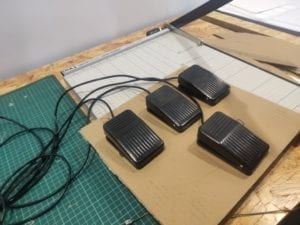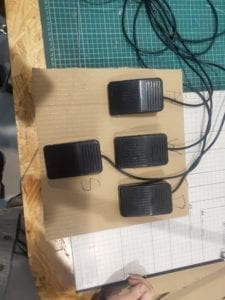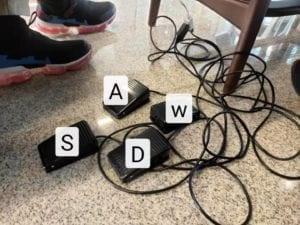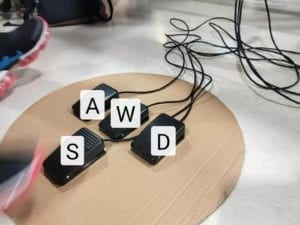Reflection for the 4-week workshop
-
-
-
Describe your partner
- My partner is a cool boy who loves to play computer games and watches movies on the computer at home.
- He loves to play the small games that don’t require too complicated movement, as he has the constraint on the left side of the body.
-
What are their desires/challenges/difficulties?
- He encounters the difficulties that when he plays computer games, he can’t play the game requiring both hands because his left hand could not move well.
-
What is your project? (Description + Photos and/or Videos)
- We’d like to propose a controller that could control by his right foot so that by substituting the left hand to the left foot, he can play games that require two hands


- That’s our final version of the project. It has four pedals fixed on the board and each of the pedals is programmed with the key “W”/”A”/”S”/”D”. 4 wires of USB come to the USB hub and the USB hub connects to the computer.
- The reason why we programmed W/A/S/D into the pedal is that many games require the WASD for the movement of the game figure, and our partner did not be able to play those games. So we want to use this board to help our partner to play the game well and try more different kinds of games.
- Once the user uses the foot to click the pedal, the signal of that specific key is activated and it instantly reacts to the computer.
-
Development process. Include photos and video(s)
- I came up with the idea of the foot controller, and we searched online for the hardware part of our project. Finally we found that Taobao has a store that provides the pedal which can be customized the key. We chose a size that is suitable for our partner’s foot. We also bought a USB hub for sorting the wires better.
- After the pedals and USB hub arrived, we programmed it with the given tutorial by the seller.
- We first assemble 4 padels in this way

- However, we found that in this position, the user could easily be tired as the user has to move the foot position quite often.
- Then we change the padels in this position
-

- We found that in this position, the user only has to change the foot’s direction from left to right when the user needs to click S+D. Apart from that, every click and combination could be click in the left food direction.
-
-
What were your difficulties?
- Before the user testing with our partner, we thought that the biggest difficulty we face was how we should put 4 pedals in a way that is more convenient and efficient for the partner to use.
- However, during the user test, we found that the biggest difficulty is that he actually did not like the idea of playing games with the left foot and it’s hard for us to know the reason. When we opened several games for him to test the pedals. Even with our instructions and demonstration by ourselves, he did not like to use the pedal for games, and the most difficult thing for us is that since he’s deaf and his handwriting basically can’t convey his meaning(he could only write around 2 characters at a time) We can’t get the reason why he thought the pedal is not useful for him. And his mother, who does not like him to play the games, was kind of unwilling for him to try more about these pedals. Since that’s the one and last time we tested for this pedal, we don’t have more time to test it.
- We asked our partner whether he wanted to keep it or not, and after several confirmations between his mother(who was not really willing to do so…) and him, they brought it home and said they might test it more.
-
What did you learn from this 4-week workshop?
- Looking back at this 4-week workshop, I learned that communicating is the most important part of designing a thing for others. Since our partner is deaf and lack of the ability to write a full sentence. It was hard to get his thought and understand what he actually wants. I remembered the first time we met with our partner and his mother. Most of the time, the conversation was dominated by his mother, and my partner could not have a chance to speak for himself. We actually did not get much information about himself. After the first time, we tried to ask our partner without the presence of his mother, but it turned out that he could not understand our writing and it was hard for him to understand a full sentence. When he could not understand our meaning, he was anxious and really wanted to find his mom to speak for himself.
- If we could have more time, I think we might be able to find a really effective way to communicate with him. However, within such a short time, we found that it is hard to change his tendency to find his mother to speak for him and let his mother translate the meaning.
- Although our project eventually did not perform well and improve much of his life quality, it is a precious chance for us to know that through the process of designing, finding an effective way to communicate and knowing what the user wants is the foundation of design. Without these, all the designs we proposed may not work for our real users.
- We would keep in touch with our partner to see if he has more feedbacks for our project. All of us have learned a lot and I believe we will learn from this lesson and improve more in the future design projects.
-
-